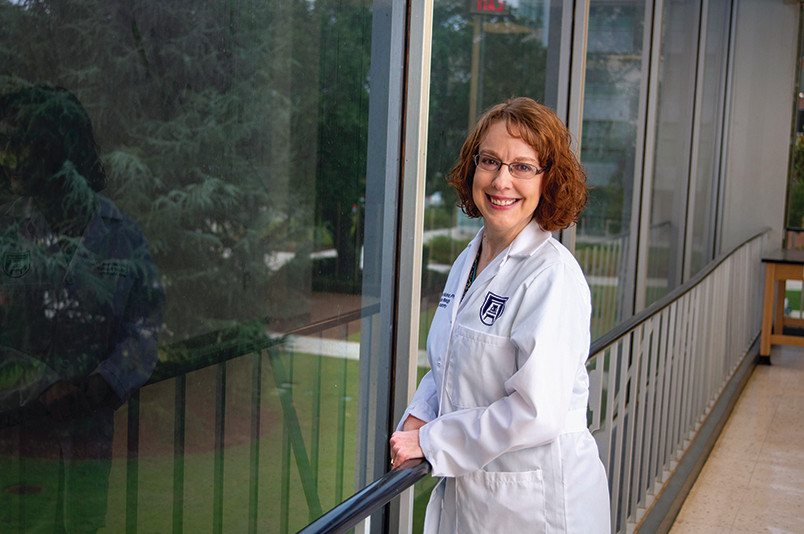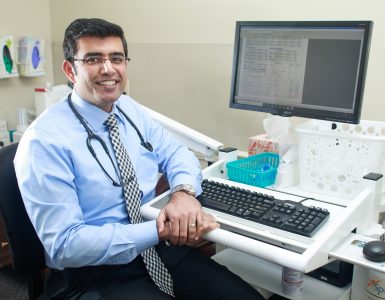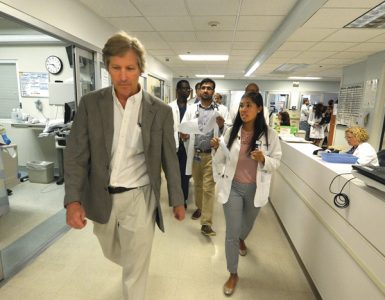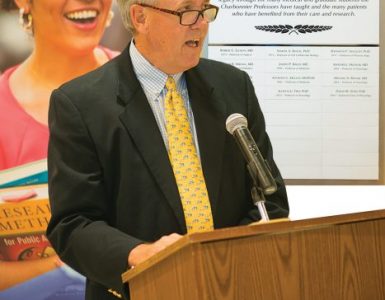She was an adult before she figured out why her mother wouldn’t let her roller skate as a child.
Born with cerebral palsy — the result of a birth injury — Dr. Carol Nichols says her mother Martha rarely told her that she couldn’t do something because of her different abilities. “I did almost everything everyone else did.” Her father James played the opposite side of the fence. “He was always the overprotective one,” Nichols says. “I suppose I have always lived my life trying to prove her right and him wrong.”
That tenacity she developed early has served her well throughout life.
During childhood, it helped her through agonizing tendon release surgeries every other summer to increase her range of motion.
It helped when she decided to leave graduate school at Clemson because the big university just wasn’t the right fit for her. Instead, enrolling in the Cellular Biology and Anatomy graduate program at the Medical College of Georgia to study cell biology. She had aspirations to one day teach science at the college level and the MCG program was a practical choice because it was close to her aging parents. But more than that she says she quickly fell in love with the department and its faculty.
It helped her when one of her MCG research mentors gave her some forthright career advice.
While working in the lab of heart development researcher, Dr. Tony Creazzo, the then-director of the Developmental Biology Program Dr. Margaret Kirby asked her what she wanted to do after graduate school, then point blankly told her “Carol, it’s obvious you’re not cut out for research. You need to take gross anatomy and make yourself marketable.”
“She actually gave me the best piece of career advice I’ve ever received. Research just wasn’t my thing, but I’ve always loved to teach,” Nichols says. “I have always loved school and the people I admired most were teachers. I wanted to be like them.”
So, Nichols enrolled in a four-week basic anatomy course with a group of students from the College of Allied Health Sciences.
When she was done, that lifelong tenacity — and a newly discovered love of human gross anatomy — drove her to march into then-chair of the MCG Department of Cellular Biology and Anatomy Dr. Sally Atherton’s office and tell her that she wanted a job. “It was that or naiveté at its finest,” Nichols says. “I told her I had four weeks of experience and wanted a job as a gross anatomist. But she hired me.”
Nichols’ teaching career began that summer when she taught histology during the Student Educational Enrichment Program (see page 48). She started teaching anatomy in the medical school that July.
In the two-decades since, Nichols has more than earned the job she says she so “naively” asked for.
She served as director of the Medical Gross Anatomy Program from 2007-18, before handing that job over to a junior colleague who wanted additional responsibilities in the medical school’s curriculum.
She has led the first and formative pre-clerkship years of medical education at the state’s only public medical school.
She has been part of a team leading an innovative redesign of the medical school’s four-year core curriculum to three, enabling students to better tailor-make their fourth-year learning experience.
She has been the recipient of 11 MCG Exemplary Teaching Awards; three Excellence in Teaching Awards; and two Distinguished Faculty Awards for Basic Science Teaching.
She has served as a member of the US Medical Licensing Exam Step 1 Gross Anatomy Test Development Committee.
She has served the International Association of Medical Science Educators as chair and a member of its Professional Development Committee and as a member of its Board of Directors and Oversight and Chairs committees.
Now, she has been recognized by that international group as the recipient of one of its top honors — the 2020 Distinguished Career Award for Excellence in Teaching and Educational Scholarship.
Knowledge will come
That four-week gross anatomy course was incredibly tough, Nichols says, “but I absolutely fell in love with it. It was the first time that I thought to myself ‘Wow! This is my thing. This is what I want to do.’”
Yet she acknowledges that her career as an anatomist and medical educator at MCG came very close to never happening.
Scheduled to finish her PhD in 1999, for some reason all of the experiments she was doing to finish up her research suddenly stopped working. “We were cell culturing. The cells would not live.”
The experiment failures and their delay of her graduation were actually fortuitous.
The university introduced an early retirement program in 2000 and many of the anatomists in the department took the opportunity, leaving several teaching positions available.
She likens her early experiences teaching to “jumping off the edge of the pool with no water rings on. I still remember one of my very first course evaluations in December 2000. It said: ‘Very nice person. Actual anatomy knowledge will come,’” she says laughing.
While she may have initially felt like she was drowning, there were people there to help her stay afloat by honing her skills in gross anatomy.
Like longtime faculty member and anatomist Dr. Tom Gale, who in her early teaching days would spend countless hours with Nichols in the anatomy lab, working through dissections. “He taught me anatomy. I learned a lot in my four-week course, but no one learns all they need to in four weeks,” she says. “Tom really took me under his wing. It’s because of him that I really grew into an anatomist.”
And fell further in love with anatomy.
“This work allows me and my students an introduction to the human body that almost nobody gets to experience,” Nichols says. “It’s beautiful, it’s absolutely beautiful. I know we’re not supposed to get religious, but I can see God’s handiwork every time I look at a body. It’s an incredible gift to be able to look inside of another human body the way that we and our students get to.”
Learning from each other
A different type of gift Nichols says she often ponders is being able to educate future generations of physicians —watching them grow from their first wide-eyed days in the gross anatomy lab and in the classroom, then watching them become physicians. “It’s an incredible metamorphosis to see, from the first day that students are here until they graduate and you see them get their hood and think ‘I’d like that person to take care of me and my family.’”
Being a part of students’ life-changing metamorphoses is something she calls a privilege.
Sometimes it’s the students that change her life.
That’s exactly what happened in 2004 when then-MCG MD/PhD student Mark Witcher bounded into her office. Known for his high energy and curious nature, his presence in her office wasn’t all that surprising. But what he told her was.
Witcher was interested in neurosurgery and was in the midst of his PhD work, but still took every opportunity he could get to shadow in the operating room. That morning he’d been shadowing former chair of the Department of Neurosurgery Dr. Cargill Alleyne as he performed a procedure called a selective dorsal rhizotomy on a pediatric patient with cerebral palsy. The procedure treats muscle spasticity caused by abnormal communication between the brain, spinal cord, nerves and muscles. It corrects muscle spasticity by cutting the nerve rootlets in the spinal cord that are sending abnormal signals to muscles.
“I immediately thought of you,” he told her. “Most students I interact with never make mention of an obvious disability, but not Mark. He asked if I’d ever heard of it and then he told me he asked (Alleyne) if this could be done on adults ‘because you’re not much bigger than a child.’”
Alleyne told the eager student it wasn’t, but Witcher wasn’t one that liked to take no for an answer. Neither did Nichols.
The two agreed to independently research the procedure for two weeks — how it worked, where it was done and on who — and then get back together to talk about their findings. While they found that the surgery was mostly done on children, like Alleyne had suggested, they also found the one place in the country performing the procedure on adults.
On February 11, 2005, at the age of 33, Nichols became a “geriatric patient” at the St. Louis Children’s Hospital.
Life was changed again.
“It gave me a good solid decade of increased mobility, reduced muscle tightness and spasticity. It improved my gait. It improved my movement. One thing it did do was negatively affect my balance, which is why I use this more,” she says pointing to a walker. “But with all of my muscles taking a deep breath,
I gained almost an inch in height.”
And for the first time, she could dance with her husband Stan DeHoff, who she had married just a year before.
“Another medical student gave us the gift of some dance lessons,” she remembers. “We practiced in the lobby of the (Carl T. Sanders Research and Education) building. I would never be on Dancing with the Stars, but…Those are just two different medical students, out of many, that were life changing for me.”
Witcher, now a neurosurgeon in Roanoke, Virginia, says Nichols is life- changing as well.
“I just hold her in such high esteem. She is such an awe-inspiring person,” he says. “I can still remember her scurrying over to save whatever dissection we were working on during that first year of medical school. She had a pair of gold-handled scissors and we all wanted a pair because she had them. To this day, when I operate with gold-handled instruments, I think of her.”
In her two decades at MCG, Nichols has mentored nearly 30 medical students through various educational research projects, taking many of them with her to IAMSE meetings to present and investing in their professional development.
“It’s the right thing to do. I love it when they come to me and say ‘I have an idea.’ It’s a symbiotic relationship though,” she says. “I have learned so much from them.”
Pausing a minute, she adds “That’s what happened with me. I didn’t quite walk into Sally’s (Atherton) office and say ‘I have an idea,’ but she invested a lot of time and energy in me, as did a lot of other people. I’m emulating the people that I admire.”
 More About Dr. Carol Nichols
More About Dr. Carol Nichols
A native of Fort Hood, Texas, Nichols grew up in the Northwest part of Georgia in a small town named Cedartown. Her mother, Martha, had moved back to be closer to family after she and Nichols’ father divorced. Martha met James Nichols there and the two married when Carol was 6. James adopted her, which is one of the reasons she kept his last name as an adult. Martha turned 75 in July and James turned 93 in October.
She met her husband Stan DeHoff on a blind “second” date — they decided they would have a second date because first dates are too nerve wracking. They dated for a year-and-a-half before getting married on a Tuesday — April 20, 2004 —surprising everyone except the immediate family they had told beforehand.
Besides just being a lot of fun and keeping her laughing, she calls him a large part of her success. “He’s a champion for me. He’s been to every single professional meeting that I’ve been to. He’s good natured,” she says. “The practical truth is that not only is he emotionally supportive but he’s supportive in tangible ways. I can’t travel by myself. If he were not willing to go with me to a meeting, if he weren’t willing to go with me a lot of places, I would have been very limited. My circle would be small.”










